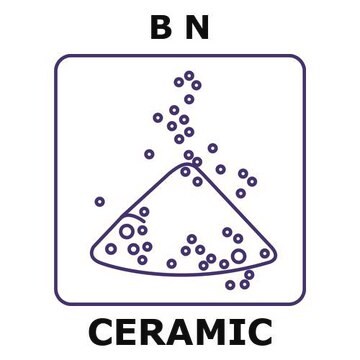900405
Boron nitride
nanoplatelet, lateral dimensions <1 micron
Sign Into View Organizational & Contract Pricing
All Photos(1)
About This Item
form
powder
composition
solids BN, ≥95 wt. %
Surfactant, ≤5 wt. %
InChI
1S/BN/c1-2
InChI key
PZNSFCLAULLKQX-UHFFFAOYSA-N
Looking for similar products? Visit Product Comparison Guide
Application
Extremely thin layers of boron nitrides (BN) have emerged as an important class of non-graphene based 2D-material and find applications in flexible & printed electronic, LEDs, and sensors.
Storage Class Code
13 - Non Combustible Solids
WGK
WGK 3
Flash Point(F)
Not applicable
Flash Point(C)
Not applicable
Choose from one of the most recent versions:
Certificates of Analysis (COA)
Lot/Batch Number
Sorry, we don't have COAs for this product available online at this time.
If you need assistance, please contact Customer Support.
Already Own This Product?
Find documentation for the products that you have recently purchased in the Document Library.
Customers Also Viewed
Flexible and Transparent MoS2 Field-Effect Transistors on Hexagonal Boron Nitride-Graphene Heterostructures.
Leet GH, et al.
ACS Nano, 7(9), 7931-7936 (2013)
F Withers et al.
Nature materials, 14(3), 301-306 (2015-02-03)
The advent of graphene and related 2D materials has recently led to a new technology: heterostructures based on these atomically thin crystals. The paradigm proved itself extremely versatile and led to rapid demonstration of tunnelling diodes with negative differential resistance
In vivo profiling and visualization of cellular protein-lipid interactions using bifunctional fatty acids.
Per Haberkant et al.
Angewandte Chemie (International ed. in English), 52(14), 4033-4038 (2013-03-02)
Per Haberkant et al.
Biochimica et biophysica acta, 1841(8), 1022-1030 (2014-01-21)
Understanding biological processes at the mechanistic level requires a systematic charting of the physical and functional links between all cellular components. While protein-protein and protein-nucleic acid networks have been subject to many global surveys, other critical cellular components such as
Our team of scientists has experience in all areas of research including Life Science, Material Science, Chemical Synthesis, Chromatography, Analytical and many others.
Contact Technical Service